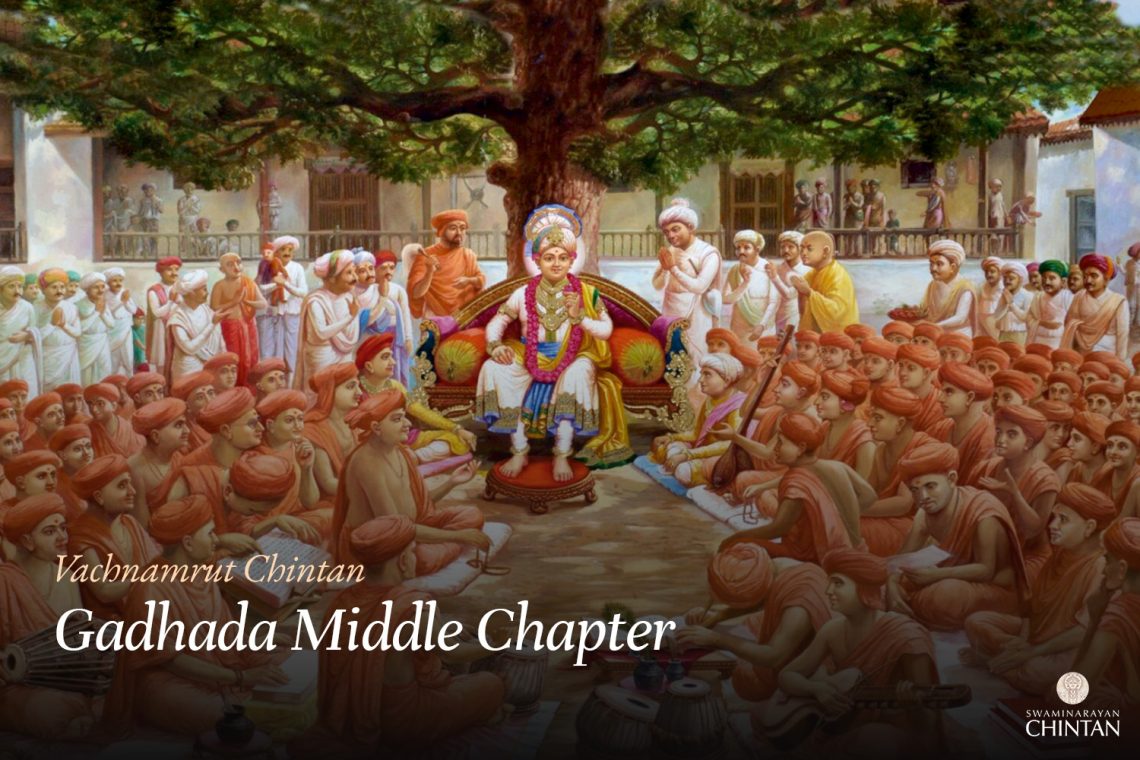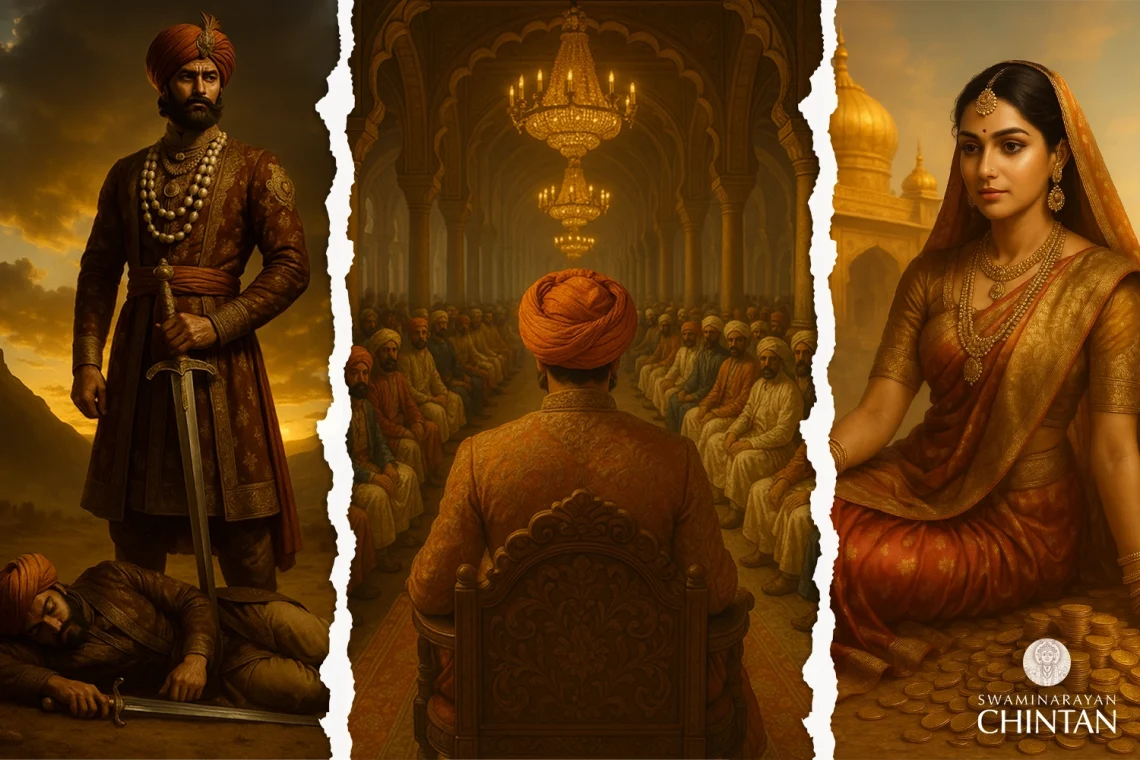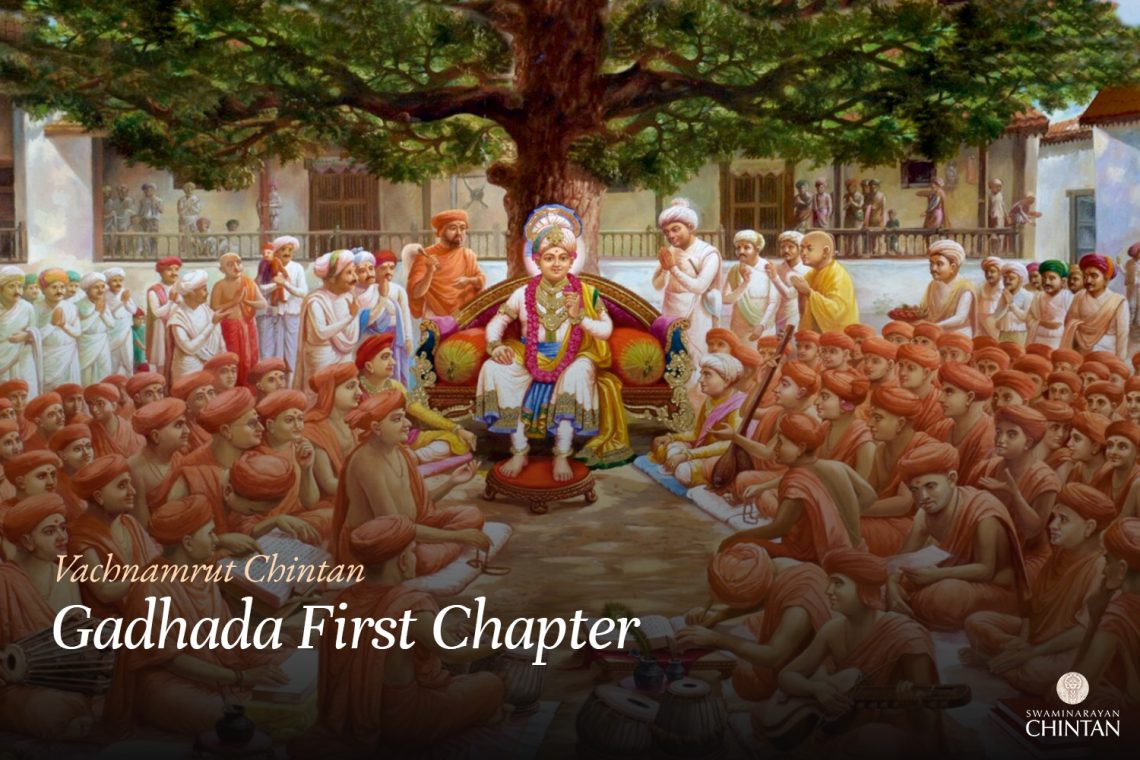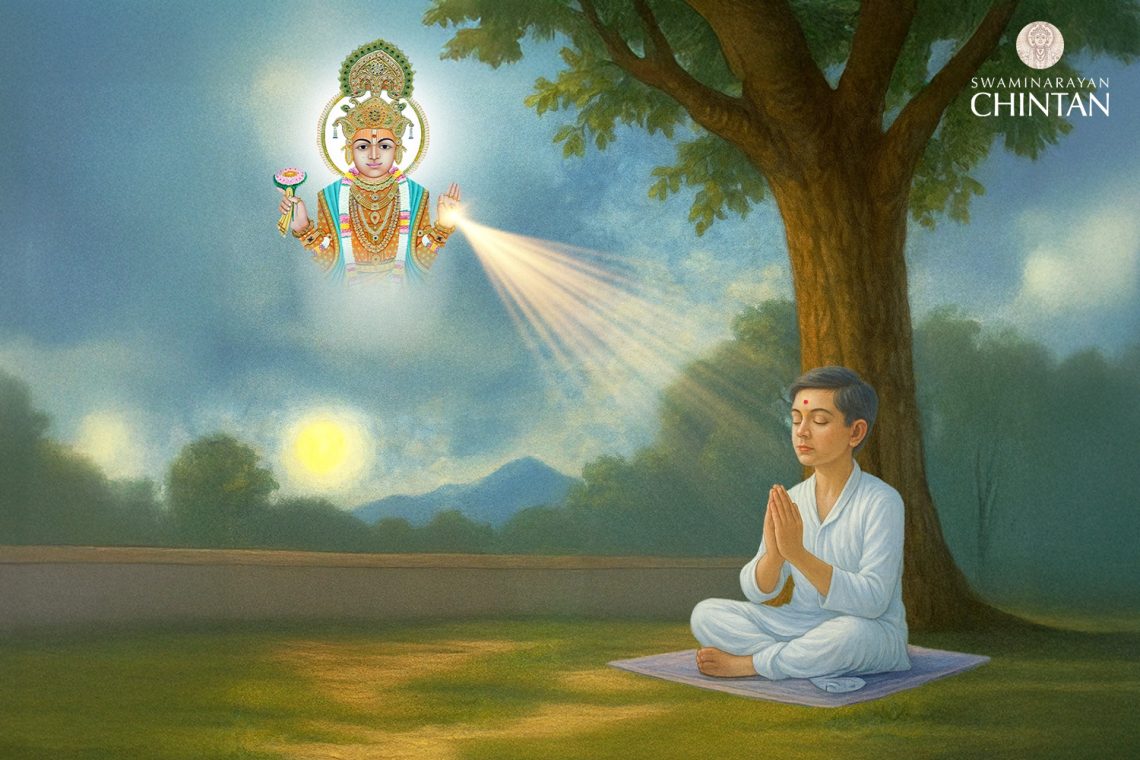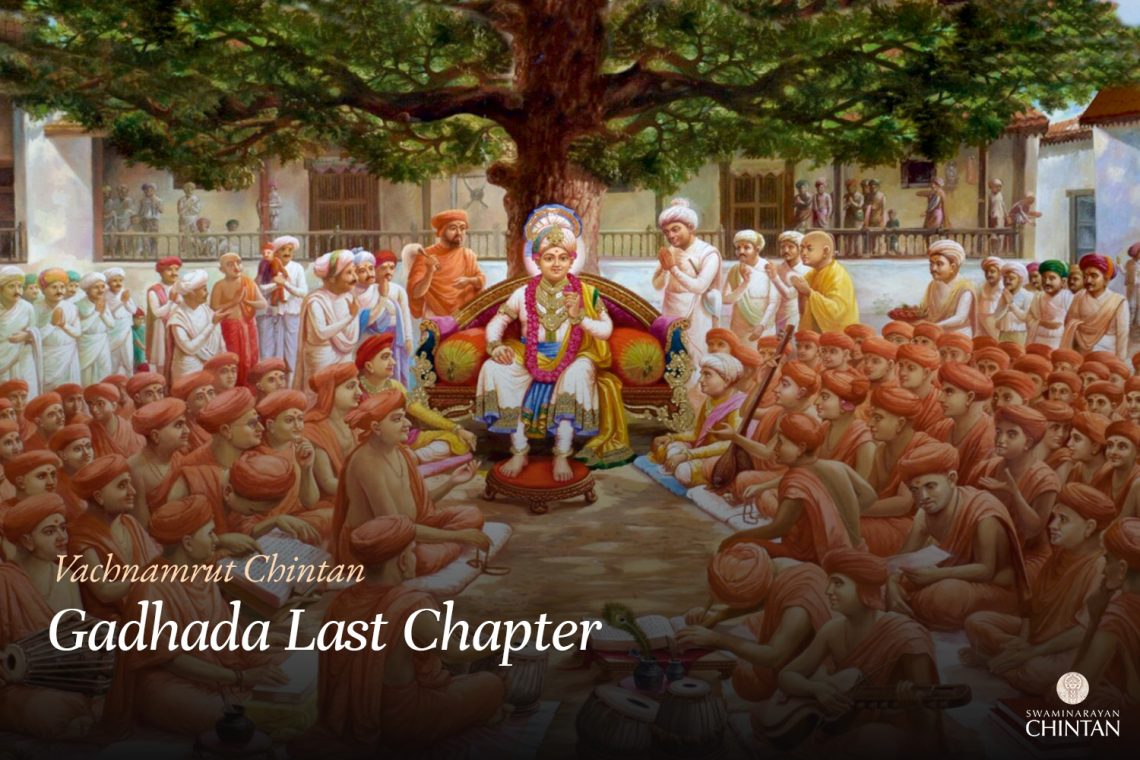Time Measurement in Human vs. Divine Terms Let’s take a step back and grasp the enormity of Brahmaji’s lifespan. In our daily lives, time feels short—24 hours rush by, and a year passes before we even notice. But in Vedic cosmology, the scale of time stretches far beyond human comprehension.…
GM-54 The Superiority of Satsang Over All Other Spiritual Endeavors
Central Insights: Key Points: Explanation: In this Vachanamrut, Shreeji Maharaj references a verse from the twelfth chapter of the Eleventh Canto of the Bhagavat Purana, where Shri Krishna tells Uddhav, “Through astanga-yoga, sankhya, austerity, renunciation, pilgrimages, vows, sacrifices, or charitable acts—I am not won over to the extent that I…
Rise above the Attachment of Woman, Wealth & Power
स्त्रियाः धनस्य वा प्राप्त्यै साम्राज्यस्य च वा क्वचित्। मनुष्यस्य तु कस्यापि हिंसा कार्या न सर्वथा ॥१३॥ None shall ever kill a human being for obtaining women, wealth or even for a kingdom. Human Birth: The Gateway to Liberation From the earliest scriptures to the teachings of sages, one truth remains…
Mind Your Words – Your Words Can Either Help or Hurt!!
मिथ्यापवाद: कस्मिंश्चिदपि स्वार्थस्य सिद्धये ।नारोप्यो नापशब्दाश्च भाषणीया: कदाचन ।।२०।। None shall ever make false accusations against anyone, even for serving self-interest, and one shall never abuse anyone. This verse underscores the importance of speech and the moral responsibility to uphold the truth. Authored by Bhagwan Swaminarayan, the Shikshapatri guides devotees…
GF-55 Resoluteness in Worship, Remembrance and Observance of Religious Vows
Central Insights: Key Points: Explanation In this Vachanamrut, prompted by Shreeji Maharaj’s encouragement, Muktanand Swami raises a question: Why does the jeev not maintain consistent firmness in bhajan, smaran, and in observing vartaman? Shreeji Maharaj replies that such inconsistency is due to the influences of desh (place), kal (time), kriya…
GF-53 Progression And Regression In Satsang
Central Insights: Key Points: regress day by day. Discussion: This Vachanamrut addresses the reasons for spiritual growth and decline within the fellowship of Satsang. Shreeji Maharaj reveals who moves forward and who falls back on the path to kalyan (liberation). Inspired by Maharaj’s encouragement to pose questions, Muktanand Swami asks:…
Where should we maintain Divya Budhhi?
Introduction: A Question By Maharaj. In Vachanamrut Gadhada’s First Chapter 67, Maharaj asks if any such true Santos are detached from all worldly pleasures and have desires only for the bliss of Bhagawan’s abode and the joy of His divine form. These Santos engage in practices to attain these two…
Sthiti Attained by Gnan: Understanding Spiritual Stability Through Knowledge
Introduction Sthiti in the spiritual context refers to an unwavering state of stability in devotion, faith, and realization of Bhagwan’s eternal presence. A devotee who attains spiritual steadiness through Gnan (divine knowledge) experiences divine bliss (ānand) and remains unaffected by external circumstances—whether favorable (anukūltā) or unfavorable (pratikūltā). This article explores…
How to Overcome Worldly Desires (Vasana) and Attain Spiritual Liberation
Introduction: The Struggle of Desires in Spiritual Life One of the biggest challenges in the spiritual journey is overcoming vasana—deep-rooted worldly desires that bind the soul (jiva) to material existence. Bhagwan Swaminarayan, in His divine discourses, emphasized: “Renouncing desires is the greatest of all spiritual endeavors.” While many focus on…
Purifying the Intellect: Aligning with Bhagwan’s Will for Spiritual Growth
Introduction: Why Purifying the Intellect is Essential for Spiritual Progress In Vachanamrut Gadhada Middle Chapter 45, Bhagwan Swaminarayan explains the necessity of detaching the jivatma (soul) from the limitations of the mind (mann) and buddhi (intellect). He emphasizes that true spiritual progress requires aligning one’s consciousness with divine wisdom, rather…
42. A saint accepts advice even from an enemy
A fake saint never accepts advice Sadguru Nishkulanand Swami says that the one who can accept someone’s advice for his own kalyan is a saintly soul; the one who cannot accept someone’s advice for his own kalyan, and who cannot even wish to hear the advice is an unsaintly soul.…
GL-39 Vishalya-Karani Herbal Medicine; There Is Only One God
Central Insights: Key Points: Explanation: In this Vachanamrut, Maharaj begins by explaining that transcending Maya (illusion) and fostering love for Bhagwan is the fundamental principle of all scriptures. What constitutes Maya? It is the attachment formed by Aham (sense of “me-ness” regarding one’s body) and Mamattva (sense of “my-ness” regarding…
GL-38 Avoiding The Six Desires
Central Insights: Key Points: Explanation: In the initial part of this Vachanamrut, Maharaj explains swaroopnishtha (faith in the divine form). Understanding who the manifest Shreeji Maharaj is and His greatness leads to swaroopnishtha. Maharaj has subtly revealed His identity in this Vachanamrut. Maharaj states, “We have arrived at a conclusion…
GL-37 Objects Enjoyed Previously are Remembered in Times of Poverty
Central Insights: Key Points: Explanation: In this Vachanamrut, Shreeji Maharaj explains that once a person truly realizes the divine nature of Bhagwan in their heart, this understanding never diminishes, even if adverse circumstances such as time or place arise. For instance, Bharatji retained the memory of Paramatma’s divine form and…
GL-36 The Extraordinary Means of Salvation
Central Insights: Key Points: Explanation: In this Vachanamrut, Shreeji Maharaj poses a question:“What is the extraordinary means by which the soul can attain salvation unfailingly, and what is the greatest obstacle that can cause one to falter on this path?” Thereafter, Maharaj Himself provides the answer:The extraordinary means of salvation…
GL-35 Forcefully Altering One’s Innate Nature; God is maligned When His Devotee is Maligned
Central Insights: Key Points: Explanation: Shreeji Maharaj begins by addressing a question posed by Shukmuni. The query explores the mental and behavioral attributes of a devotee whose firm refuge in Bhagwan and His devotees remains unshaken under any circumstances—whether it be bodily happiness or suffering, honor or insult, or adverse…
GL-34 Maintaining Desires Only For God
Central Insights: Key Points: Explanation: In this Vachanamrut, Shukmuni poses a question to Shreeji Maharaj: “How can one eliminate desires for all worldly objects and maintain desire solely for God?” Two means are mentioned: one is bhakti (devotion) toward God, and the other is vairagya (non-attachment) accompanied by gnan (knowledge).…
GL- 33 Avoiding the Infiuence of Four Obstacles
Central Insights: Key Points: Explanation: In this Vachanamrut, Maharaj addressed the Santo and explained that wealth, women, and sons are objects that nurture attachment to the body and its pleasures. These attachments cause the intellect to falter, decisions to walk on the path of Bhagwan to waver, or one’s resolve…
GL-32 Committing Sins Under The Excuse Of God’s Greatness
Central Insights: Key Points: Explanation: In this Vachanamrut, Shreeji Maharaj posed the question: “Will you explain the verse of the Gita, विषया विनिवर्तन्ते निराहारस्य देहिनः — viṣayā vinivartante nirāhārasya dehinaḥ, When the saints provided explanations based on Ramanujacharya’s commentary, Maharaj expressed His own unique understanding:“I have determined thus.” Here, Maharaj…
GL–31 Meditation with the Analogy of Shadows
Central Insights: Key Points: Explanation: In this Vachanamrut, Shreeji Maharaj first had the saints sing devotional hymns of loving devotion (prembhakti). He then spoke about a topic that greatly benefits those who practice meditation. Maharaj explained that Akshardham, Bhagwan’s abode, is of the nature of Brahm—a limitless ocean of radiant…
GL-30 Constant Awareness of Five Thoughts
Central Insights: Key Points: Explanation: In this Vachanamrut, Shreeji Maharaj states that two things are deeply pleasing to Him, capturing His complete focus. Beyond these two matters, nothing else holds His interest. They represent the ultimate goals. The first is worshiping Paramatma with the conviction that His divine, sakar image…


